Feature
For our tomorrows: Refining facets of sustainability
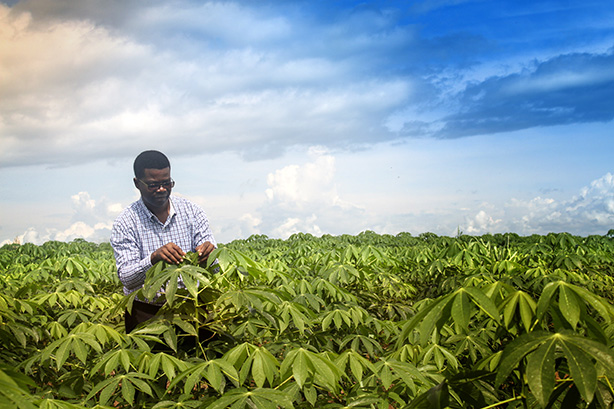
Chiedozie Egesi, Cornell's NextGen Cassava project manager, examines a field of the starchy plant in Nigeria. Cassava stands up well to drought and marginal soil, and can be stored long term.
As the planet warms, arable land decreases and population grows, global agriculture is facing a dilemma, prompting farmers and researchers to be agile and creative in responding to these critical challenges. Staples like maize and wheat come up short against a changing climate, but cassava – a once-neglected key crop – shows promise for feeding millions.
Cassava, also called yuca or manioc, is a low-cost carbohydrate. Americans make pudding from tapioca derived from the root, but to 250 million farming families in sub-Saharan Africa who consume the starchy vegetable daily, it is a major staple. Cassava stands up well to marginal soil, drought and long-term storage. As a critical food and nutrition source, Africa's small farmers produce more than half the world's cassava, about 86 million tons on 25 million acres.
Chiedozie Egesi manages Cornell's NextGen Cassava project, a global consortium of scientists who are working to unlock the full potential of the versatile crop. Egesi explains that beyond eating it, farmers can process and sell it. In its flour form, it compares well with wheat. "If you use the right combination of good seed, good agronomy and good extension delivery systems, cassava can sustain a nation," he says.
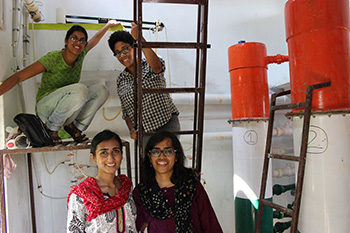
Clockwise from top left: Maysoon Sharif, M.Eng. '11, Sarah Long '09, doctoral student Shiuli Vanaja and Uttara Gadde '15 share a light moment inside an AguaClara water treatment plant at the village of Gufu, Jharkhand, India. See larger image
Cassava actually benefits from a warming climate. "Where climate change is happening, cassava outperforms other major crops," says Egesi. "It's a major staple crop for poor families on marginal land – and it is mainly grown and produced by women."
In 2012 the Bill & Melinda Gates Foundation and the U.K. Department for International Development awarded $25 million to researchers from Cornell, Uganda, Nigeria, Ghana, Tanzania and other countries and agencies to improve cassava genetics. Egesi says breeding nutritional enhancement into the plant is time-intensive, as genotypes flower poorly, making it hard to crossbreed. "It's a lengthy process, and it can take up to a decade to release new varieties," Egesi says. "We're working to shorten its breeding cycles."
In collaboration with the NextGen Cassava project, researchers at the Boyce Thompson Institute, a Cornell affiliate on the Ithaca campus, have developed a key component to bolster the crop: Cassavabase, a genetic database for cassava breeders worldwide.
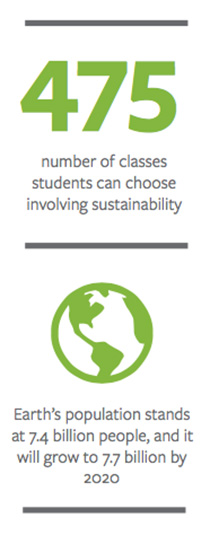
Lukas Mueller is a Cornell associate professor whose BTI laboratory includes postdoctoral researchers Guillaume Bauchet and Naama Menda; Jean-Luc Jannink, a U.S. Department of Agriculture research geneticist and adjunct professor, and Isaak Yosief Tecle, a bioinformatics consultant, furnish added expertise to the lab using genomics-assisted breeding to hone cassava traits – such as size, flavor and disease resistance – while the plants are still seedlings.
Says Mueller: "For plant improvement, we're speeding up the process a lot."
It starts in the classroom
The cassava project is but one of countless examples of Cornell University's reach – across disciplines, approaches and the globe itself – into the intersecting world of sustainability.
Cornell students, faculty and alumni are nourishing and transforming the world's sustainability machinery.
As reflected in Ezra Cornell's "any person … any study" philosophy, the world itself is an intricate place where scientists, sociologists, humanists, lawyers, biologists, oceanographers and business leaders help create solutions so that clean waters flow into village homes in India, nutritious crops grow in Africa's arable lands, and growing cities use new solutions to grapple with the reality of waste.
Cornell undergraduates take advantage of a dazzling array of campus projects and apply their knowledge throughout the region and around the world. Students have 475 classes involving sustainability from which to choose, including anthropology's Indigenous Peoples, Ecological Sciences and Environmentalism, the ILR School's Labor, the Environment and Social Change, or Biological and Environmental Engineering's Renewable Energy Systems.
A new environment and sustainability major is being discussed in the College of Arts and Sciences and the College of Agriculture and Life Sciences. Its goal: To give students more ways to combine studies in physical and biological sciences with social science and humanities fields. For students, this opens the social, ethical and public policy dimensions of environmental issues.
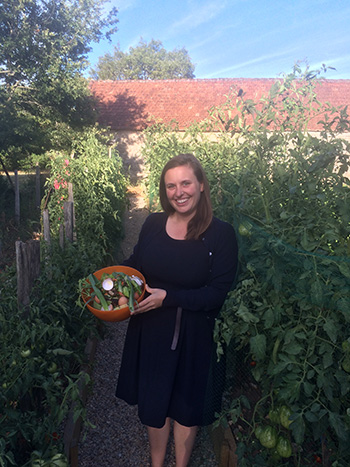
Louise Bruce '09 strives to help New York City see zero organic waste going into landfills by 2030. See larger image
The College of Business' Center for Sustainable Global Enterprise – housed at Johnson and directed by Mark Milstein, clinical professor of management – is a tapestry of partners, research projects and student opportunities that offer financially viable, self-sufficient answers to green challenges. Recent projects range from the Cheetah Conservation Fund, which saves cheetah savannah habitat from encroaching bush and compacts the woody bush into marketable cooking fuel; to suggesting international source strategies for the organic food company Made in Nature; to guiding energy companies in a changing business climate.
In less than a year, the historic opening of Cornell Tech's sustainable Roosevelt Island campus in New York City – driven by LEED (Leadership in Energy and Environmental Design) specifications, and Net Zero and Passive House principles – will give rise to continued technical creativity.
Sustainability offers hundreds of facets. Comprising more than 480 faculty fellows and 50 research fellows, Cornell's Atkinson Center for a Sustainable Future has granted millions of dollars to support faculty pilot projects that are yielding substantial environmental and economic benefits for the world. David Lodge, the research center's new director, is fostering partnerships with the Environmental Defense Fund, CARE and for-profit companies to hasten the incorporation of Cornell research innovations into on-the-ground solutions. Cornell's students hone their niches on campus, throughout the region and on an international scale in order to make Earth – environmentally, economically and socially – a thriving place.
Elders have used the aphorism "You can't save the world" as cautionary advice. Finding various ways to conduct sustainability across fields and disciplines, Cornellians may be proving that wrong.
A more potable place
Using gravity, solar power and engineered filters, Cornell students in the AguaClara program have created community water-treatment plants throughout Honduras. AguaClara LLC – the professional version of the student project, a Certified B Corporation – has now expanded to India, the next step in its goal of providing potable water around the world.
"Engineering problems are the least difficult. Understanding the cultural and political components are what's complicated," says Maysoon Sharif, M.Eng. '11, who, along with Sarah Long '09 and Karen Swetland, Ph.D. '12, kick-started AguaClara's nonprofit business version. Pilot projects in two Indian villages are now complete.
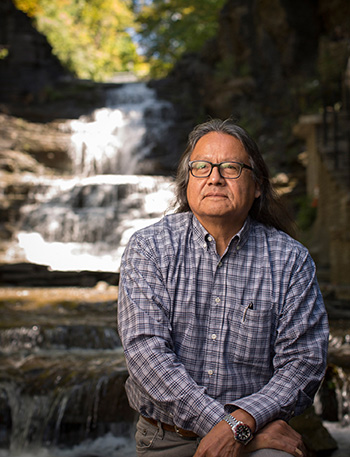
Professor Gerald Torres: "You want lawyers to be conversant with scientists to think through the best policies." See larger image
Earth's population stands at 7.4 billion people, and it will grow to 7.7 billion by 2020. Without electricity, water treatment has been virtually impossible – a reality for about 1.3 billion people, according to the World Health Organization. And about 1.5 million people – mostly children – die annually from poor water quality and waterborne disease.
Thanks to AguaClara LLC, these Indian villages have seen far fewer waterborne diseases, says Charles H. Dyson School of Applied Economics and Management doctoral student Shiuli Vanaja and Uttara Gadde '15, who graduated from the College of Human Ecology. With funding from the Tata Cornell Institute for Agriculture and Nutrition, they surveyed villagers to comprehend the time-saving impact of reliable, potable water.
With clean water nearby, village women who might have spent more than four hours a day retrieving it now only spend 30 minutes daily. The extra time enables women to handle more agricultural work and provides more leisure time in the homes.
"There are substantial time savings," explains Vanaja. "It seems from the initial field observations that the task of managing the water systems successfully may be developing community leadership among women in these villages."
Eco solutions for low-income neighborhoods
The Westside Value Laundromat represents the ascension of Buffalo's West Side – and Skye Hart '18 spent the summer of 2016 researching the neighborhood's revitalization so others can replicate its success.
Through ILR's High Road Fellowship, funded through the Engaged Cornell initiative, Hart served as an intern for the Partnership for the Public Good to document the work done by People United for Sustainable Housing's (PUSH) project in Buffalo.
Facing blighted buildings, decrepit housing and dangerous vacant lots, PUSH has – for more than a decade – offered green ideas and action to create a thriving neighborhood.
"I'm piecing it together into a cohesive narrative," says Hart.
Through Buffalo's Green Development Zone, PUSH aims to revitalize 25 blocks on the city's West Side to help residents lower their energy bills by weatherizing homes, harnessing geothermal heating, turning vacant lots into rain gardens and net-zero energy housing, and fostering community with artistic initiatives and environmental projects.
Hart's research also contributes to Buffalo's effort to implement inclusionary zoning, which integrates neighborhoods economically by requiring new, market-rate housing to include affordable units.
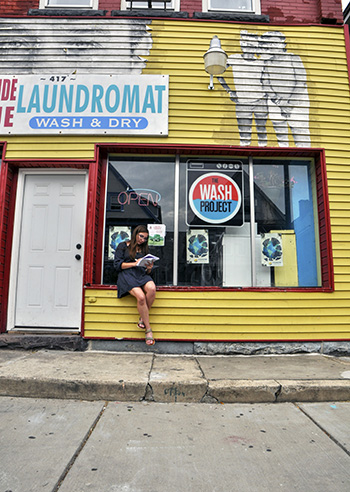
Photographed in front of the Westside Value Laundromat on Buffalo's West Side, Skye Hart '18 spent this past summer researching and chronicling People United for Sustainable Housing (PUSH) and its Green Development Zone. Photo: Victoria Neenan '17. See larger image
"That way those earning low incomes will have access to better schools, shorter commutes and public transportation, resulting in a more equitable and eco-friendly lifestyle," says Hart, an urban and regional studies major in the College of Architecture, Art and Planning. "PUSH has shown that environmentally sustainable initiatives are a solution in low-income neighborhoods."
Organic diversions
Give Louise Bruce '09 your food scraps, your yard trimmings, your organic waste yearning to compost free.
Bruce, senior program manager in the New York City Department of Sanitation, oversees the development and expansion of the agency's organic waste diversion initiatives, which include a pilot curbside collection program and neighborhood drop-off sites, all of which serve 700,000 residents. Residential and commercial organic waste – such as kitchen rubbish – accounts for 30 percent of the city's total trash. Residents of all five boroughs toss away an average of 15 pounds of garbage per person weekly, generating unimaginable tons of trash each year.
In 2015 the sanitation department's pilot program diverted 15,850 tons of organic material into compost. By late 2018, the program will become permanent and serve the entire city with either organic waste curbside pickup or neighborhood drop-off sites, with a goal to achieve zero organic waste going to landfills by 2030.
Beyond the advantages of diverting organic waste, city residents enjoy a reduction in rats. "By collecting organic waste, you might think you're creating a feast for animals," says Bruce, "but in reality we're making the food waste inaccessible to rodents by moving it from a black trash bag at the side of a curb to a sturdy bin, which has a latch that can close."
In the shadow of Brooklyn's Gowanus Expressway, Red Hook Community Farm is among the city's 87 organic waste-receiving sites, and it's the largest urban compost site in the United States that runs solely on renewable resources, says David Buckel, J.D. '87, senior organics recovery coordinator for the NYC Compost Project (funded by the city's sanitation department) and hosted by the Brooklyn Botanic Garden at the farm. Red Hook's compost – which diverts 150 tons of organic waste annually – helps to grow more than 30 crops that include arugula, heirloom tomatoes and okra for neighborhood residents and restaurants.
Large, heaping mounds formed into windrows, aerated by hand or solar-powered blowers, process the waste year-round. It takes about 2,000 volunteers annually armed with pitchforks and wheelbarrows to handle the work. Solar power runs the heat lamps to keep the volunteers' gloves warm in winter.
Says Buckel: "Volunteers love that we keep food scraps in the community to help green the neighborhood and that we do it in the most sustainable way, all by hand."
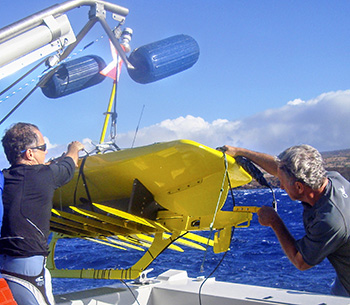
In Puako, Hawaii, professor Chuck Greene, left, with Murray Taylor of the Jupiter Research Foundation, a group that helps to develop new technology to grasp the natural world, test robotic Wave Gliders. See larger image
Raising the environmental bar
Gerald Torres, Cornell's Jane M.G. Foster Professor of Law, is an Atkinson Center faculty fellow who wears an important hat outside Ithaca: He chairs the board of the Earth Day Network, the international group that organizes Earth Day each April and links all the local celebrations. "What can lawyers bring to the table?" Torres asks. "If you're trying to improve the environment or maintain water flow for agricultural lands, it all starts with policy goals, rules and regulations. Lawyers provide a clear understanding of institutional adjustments needed to bring about natural system changes."
Torres served as deputy assistant attorney general for the U.S. Department of Justice's environment and natural resources division and as chief counselor to Attorney General Janet Reno '60 from 1993-95. For his environmental law course this fall, Torres' students are looking at compliance, enforcement, defense and counseling. And because environmental lawyers must be informed by science, many Cornell scientists visit his classroom.
"You want lawyers to be conversant with scientists to think through the best policies," says Torres. "One of the pleasures of being here is that we have some of the leading natural scientists in the world."
Allocating quality water resources will be a key challenge as climate change worsens, Torres says. For much-needed policies here and around the world, he says, "I would love to say we're going to turn it over to the scientists to draw up the policy. But the politics of it means you're still going to need to craft rules and regulations in the face of nonscientific policy objections. Lawyers, as well as scientists, will be integral to mitigating the impacts of climate change."
Break the criminal cycle: Go green
Youthful offenders have a new, verdant path to productive lives as Energy Warriors, a program that offers a positive pipeline from the criminal justice system into a world of on-the-job sustainability training, licensure and certification – and reintroduces educational opportunities – all in the name of reducing energy.
"The youth come from drugs and crime – sometimes violent and sometimes nonviolent – and we prepare them for the workplace," says Aloja Airewele, coordinator for the Energy Warriors program, a partnership between Cornell Cooperative Extension of Tompkins County and the New York State Office of Children and Family Services. "We front-load these youth with credentials, and we give them the advantage of skills – a leg up, if you will."
A rigorous year's curriculum gives students professional trade experience in creating an environmentally friendly space. From air sealing to insulation methods, understanding ducts to weatherization, the students master new skills. Additionally, they learn to communicate as they adopt talking strategies on how to address homeowners professionally, speak to co-workers with respect and weigh their own options for workplace conflict resolution.
The Energy Warriors model: classroom training, hands-on work and nurturing career connections. During the last school year, 46 youth participated from Tompkins and Delaware counties – pilot programs that have been expanded to Columbia County for the 2016-17 school year. In total, nearly 80 youth have participated in the program – and most participants, if not all – have returned to school.
In 2013, Marjorie Olds, J.D. '76, a former city of Ithaca judge and a treatment court judge who now consults on youth recidivism and re-entry issues, helped design the program from within the New York State Office of Children and Family Services. Olds reached out to Cornell Cooperative Extension for help in shaping it. Those who complete the Energy Warriors program now get a solid chance to merge back into the community.
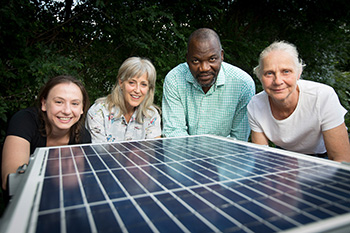
Energy Warriors team members - from left, educator Laura Komor, Marjorie Olds, J.D. '76, Aloja Airewele and educator Cheryl Starcher-Ceresna (all from Cornell Cooperative Extension of Tompkins County) - look over a solar panel. See larger image
Says Airewele: "I am not going to sugarcoat it, as the challenges have been monumental. We are now providing New York a new template to allow youth to achieve sustainable, meaningful reintegration, and this fall we will be visiting all of New York's regions to engage with them with the best practices we've found."
Creating sustainable fisheries
Oceans serve up oxygen, horde atmospheric carbon dioxide, provide protein and pump a watery pulse across this planetary blue dot we call home. Sadly for the deep and bountiful blue, humanity fouls the sea with trash and extra nitrogen, and often extracts too many fish – stressing the ecosystem's equilibrium.
To assess the ocean's fish populations, doctoral candidate Erin Meyer-Gutbrod and Chuck Greene, professor of earth and atmospheric sciences, are perfecting acoustic instruments with exquisite accuracy to outfit robotic Wave Gliders – a large surfboard-sized platform, powered by the sun and oceanic motion – to take inventory of the sea's inhabitants in real time.
Survey ships that currently do this work today are expensive – costing many tens of millions of dollars – because of maintenance, salaries and fuel needs. And, at best, these vessels survey the oceans annually. In the near future, Meyer-Gutbrod and Greene envision a fleet of hundreds or even thousands of gliders literally working around the clock for a fraction of the cost.
"The Wave Glider – and the instrumentation we develop – will provide ocean and fisheries scientists and managers with more consistent and reliable data on the distribution and abundance of marine organisms," Meyer-Gutbrod says. In the United States, finding food near the coasts goes well beyond netting fish and sending them to stores – it's a $37 billion industry that supports more than 1.5 million jobs in commercial fishing operations, wholesalers, processors and retailers, according to the National Oceanic and Atmospheric Administration.
In their quest for an aquatic inventory, Greene and Meyer-Gutbrod partner with Liquid Robotics of Sunnyvale, California, makers of Wave Gliders, and Biosonics in Seattle, makers of scientific echo sounders. Wave Gliders harness energy from waves for propulsion and gather solar energy to power environmental-sensing, navigation, control and communication systems, enabling them to operate for long periods of time.
This past September, Greene – an Atkinson Center fellow – hosted a Wave Glider exhibit at the U.S. Department of State's "Our Ocean" conference. Later this fall, in an initiative funded by the Atkinson Center and the Environmental Defense Fund, he will travel to Peru with state department officials to develop long-term coordination of fisheries management throughout the Americas.
"The ocean is vital to human survival – both environmentally and economically," says Greene. "Deleterious fishing practices not only threaten fisheries, but they also impact marine mammals, seabirds and us. Taking an accurate inventory of our seas will help us achieve a more sustainable ocean and planet."
Learn more: sustainability.cornell.edu.